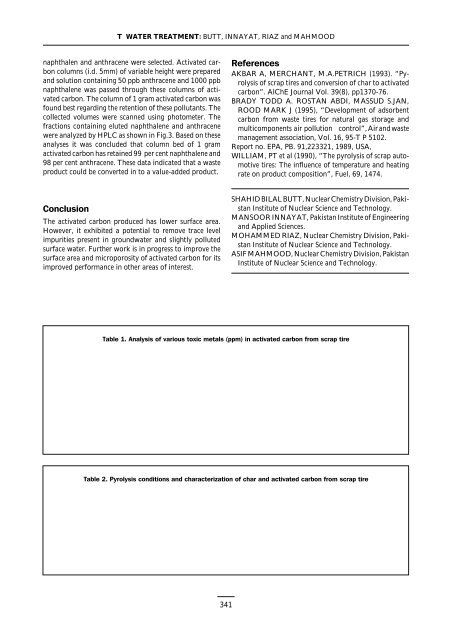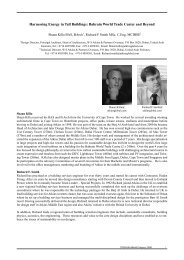Activated carbon from scrap tires for water purification - WEDC
Activated carbon from scrap tires for water purification - WEDC
Activated carbon from scrap tires for water purification - WEDC
You also want an ePaper? Increase the reach of your titles
YUMPU automatically turns print PDFs into web optimized ePapers that Google loves.
T WATER TREATMENT: BUTT, INNAYAT, RIAZ and MAHMOOD<br />
naphthalen and anthracene were selected. <strong>Activated</strong> <strong>carbon</strong><br />
columns (i.d. 5mm) of variable height were prepared<br />
and solution containing 50 ppb anthracene and 1000 ppb<br />
naphthalene was passed through these columns of activated<br />
<strong>carbon</strong>. The column of 1 gram activated <strong>carbon</strong> was<br />
found best regarding the retention of these pollutants. The<br />
collected volumes were scanned using photometer. The<br />
fractions containing eluted naphthalene and anthracene<br />
were analyzed by HPLC as shown in Fig.3. Based on these<br />
analyses it was concluded that column bed of 1 gram<br />
activated <strong>carbon</strong> has retained 99 per cent naphthalene and<br />
98 per cent anthracene. These data indicated that a waste<br />
product could be converted in to a value-added product.<br />
References<br />
AKBAR A, MERCHANT, M.A.PETRICH (1993). “Pyrolysis<br />
of <strong>scrap</strong> <strong>tires</strong> and conversion of char to activated<br />
<strong>carbon</strong>”. AlChE Journal Vol. 39(8), pp1370-76.<br />
BRADY TODD A. ROSTAN ABDI, MASSUD S.JAN,<br />
ROOD MARK J (1995), “Development of adsorbent<br />
<strong>carbon</strong> <strong>from</strong> waste <strong>tires</strong> <strong>for</strong> natural gas storage and<br />
multicomponents air pollution control”, Air and waste<br />
management association, Vol. 16, 95-T P 5102.<br />
Report no. EPA, PB. 91,223321, 1989, USA,<br />
WILLIAM, PT et al (1990), “The pyrolysis of <strong>scrap</strong> automotive<br />
<strong>tires</strong>: The influence of temperature and heating<br />
rate on product composition”, Fuel, 69, 1474.<br />
Conclusion<br />
The activated <strong>carbon</strong> produced has lower surface area.<br />
However, it exhibited a potential to remove trace level<br />
impurities present in ground<strong>water</strong> and slightly polluted<br />
surface <strong>water</strong>. Further work is in progress to improve the<br />
surface area and microporosity of activated <strong>carbon</strong> <strong>for</strong> its<br />
improved per<strong>for</strong>mance in other areas of interest.<br />
SHAHID BILAL BUTT, Nuclear Chemistry Division, Pakistan<br />
Institute of Nuclear Science and Technology.<br />
MANSOOR INNAYAT, Pakistan Institute of Engineering<br />
and Applied Sciences.<br />
MOHAMMED RIAZ, Nuclear Chemistry Division, Pakistan<br />
Institute of Nuclear Science and Technology.<br />
ASIF MAHMOOD, Nuclear Chemistry Division, Pakistan<br />
Institute of Nuclear Science and Technology.<br />
Table 1. Analysis of various toxic metals (ppm) in activated <strong>carbon</strong> <strong>from</strong> <strong>scrap</strong> tire<br />
Table 2. Pyrolysis conditions and characterization of char and activated <strong>carbon</strong> <strong>from</strong> <strong>scrap</strong> tire<br />
341



